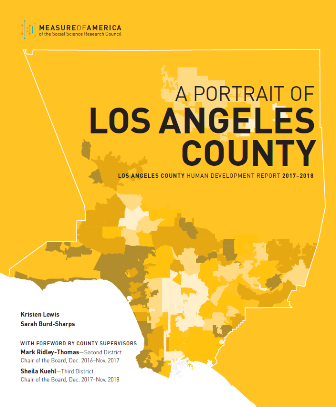The recent report, A Portrait of LA County,1 Social Science Research Council, 2017More Info → from the Social Science Research Council’s Measure of America program, provides a clear, if also somewhat disturbing, characterization of life in one of America’s most populous metropolitan areas. The report reveals stunning differences in quality of life that are highly correlated with geography as well as race/ethnicity and the socioeconomic composition of communities. Utilizing the “Human Development Index” as its barometer, the report shows that in critical areas such as health, education, and income, gross inequities limit access to opportunity for many residents of the county and contribute to the persistence of deeply entrenched social and economic disparities. The report also suggests that the fragmentation of the region has created five distinct subregions that face very different prospects and challenges.
Social Science Research Council, 2017More Info → from the Social Science Research Council’s Measure of America program, provides a clear, if also somewhat disturbing, characterization of life in one of America’s most populous metropolitan areas. The report reveals stunning differences in quality of life that are highly correlated with geography as well as race/ethnicity and the socioeconomic composition of communities. Utilizing the “Human Development Index” as its barometer, the report shows that in critical areas such as health, education, and income, gross inequities limit access to opportunity for many residents of the county and contribute to the persistence of deeply entrenched social and economic disparities. The report also suggests that the fragmentation of the region has created five distinct subregions that face very different prospects and challenges.
Though many aspects of the report are quite illuminating, many of its findings will probably not surprise those who are familiar with the region. The affluent northwest communities of Malibu, Bel-Air, and Brentwood bear little resemblance to the poorer communities in the southeast corner of the county. As is true throughout the United States, economic inequality has profoundly shaped the lifestyles, well-being, and quality of life of LA County residents in the twenty-first century.
Though the portrait is not granular in its detail, it is nonetheless compelling. It succeeds in calling attention to the glaring disparities that impact quality of life throughout the county, exacerbated by rising housing costs, limited educational and economic opportunities, and adverse environmental conditions that are contributing to deteriorating health outcomes for some residents. It also draws attention to the plight of the county’s most vulnerable residents and makes a resounding call for concerted intervention.
Interconnected spaces
Yet, despite the tremendous value of this report, there are two crucial omissions that undermine its value as a resource for decision-makers.
First, the report overlooks how porous the social, economic, and physical boundaries dividing communities are despite decrying the degree of race-class segregation and the pernicious fragmentation throughout the county. There is a degree of interconnectedness that many residents fail to comprehend. By attempting to disaggregate patterns and trends in order to produce an accurate portrait of the county, the report may very well allow policymakers, and many of the more affluent residents, to cling to the misconception that the fates of the most disadvantaged communities are separate from their own.
While in many respects, separations based on social and geographic boundaries are real and measurable, the recent fires in Bel-Air provide a pointed reminder of how connected we are nonetheless. Though Bel-Air has the highest Human Development Index score in the county at 9.51,2Lewis and Burd-Sharps, A Portrait of Los Angeles County, 38. homeless people are also known to live in the community in unregulated dwellings. In fact, investigators learned that the fire had been caused by a homeless encampment. The subsequent destruction of over seven hundred homes reminds us homelessness is not a problem that is limited to certain communities.
This is just one of the ways in which a region that appears to be so fragmented by race, class, and geography is actually quite interdependent. Had the report drawn attention to the rippling effects many of the trends identified have upon the entire county, it could have highlighted how some residents who endure conditions that contribute to a lower Human Development Index may pose a threat to the entire region. The recent outbreak of Hepatitis B among many of the homeless in San Diego County should serve as a wake-up call that a similar health challenge could threaten LA County.
Connecting housing, transportation, and education
Second, the report does not issue a clear and unambiguous conclusion and warning that LA County will eventually find itself on an unsustainable path if many of the economic and social trends identified in the report are not addressed. Again, a similar alarm could be issued about the long-term effects of economic inequality on American society generally. But with its dense population and extreme wealth disparities, the damaging effects of these trends may very well create major disruptions to the economic and social fabric of LA County—and perhaps other large metropolitan areas—long before they are experienced elsewhere.
“Long commutes operate as an unofficial tax in time and money borne disproportionately by low-wage workers.”For example, the report could draw greater attention to the ways rising homelessness and the affordable housing shortage will affect the future of the entire county, including communities that appear to be buffered by wealth and geography. The report acknowledges that rising housing costs and gentrification are forcing poor and working class people to move further away from their jobs and to endure longer commutes to work. But increased traffic congestion is only one of the problems related to this trend. Long commutes operate as an unofficial tax in time and money borne disproportionately by low-wage workers. Some of these workers (e.g., construction workers, gardeners, restaurant workers, and domestics) provide essential services to the wealthy communities and residents in the county. Without their services the high quality of life experienced by some residents would not be possible.
Moreover, the report could acknowledge the consequences of growing inequality because of the affordable housing crisis. When workers who are also parents are compelled to leave their homes in the wee hours of the morning to get to their jobs, who makes sure that their children arrive at school on time? Who helps their children with homework, cooks them dinner, or makes sure they are supervised and safe?
Long commutes and the shortage of affordable housing not only affect low-wage workers. Increasingly, it also affects a growing number of civil servants, health-care workers, teachers, and other professionals. How will the vibrancy and viability of the LA economy be maintained in the future if workers who are critical to the functioning of the economy cannot afford to live here and are unable get to work in a reasonable amount of time? In addition, given that increased vehicle traffic is linked to an increase in asthma and other respiratory illnesses, how will we address these health challenges as they grow and become more common?
The amount of productive time lost to traffic congestion is just one of the costs associated with this problem. The departure of families with children is also contributing to declining school enrollment in some school districts. Los Angeles Unified School District (LAUSD)—one of the largest employers in the county—has lost 200,000 students in the past ten years, half of which has been attributed to this trend. The economic toll already being experienced by LAUSD is staggering. Faced with multibillion dollar structural deficits caused in part by rising pension costs and declining enrollments (it is estimated 100,000 children have left for charter schools), the district will soon have no other option than to initiate mass layoffs of teachers and certified staff, a prospect which will likely worsen economic and social conditions in communities that the report describes as part of “struggling LA,” where half of county residents currently reside.
Going further
“While education features prominently in the report…its recommendations are not sufficiently ambitious.”While education features prominently in the report, both as a feature of the county’s problems and among the potential solutions identified, its recommendations are not sufficiently ambitious. For example, given the vast private wealth in the county and the presence of major institutions of higher education, it could propose the use of education as a means to counter growing inequality. This could be possible through a well-funded strategy that links education and job training to sectors where high-wage job growth is expected, such as information technology and aeronautics. The report wisely calls for expanding access to high-quality preschool. While this is important, it could bring to the front the fact that too many of the county’s poorest communities lack good schools at all levels. Additional recommendations could be: a call to launch an effort to strategically replace ineffective, under-enrolled schools with a new generation of schools that provide state of the art education and training in STEM, health sciences, and other fields with likely high-wage job growth; and a call for a comprehensive strategy to ensure schools in low-income areas are equipped with a broad range of health and social services so that they are better able to respond to student needs.
Given the likelihood that many of the trends identified in the report will continue, and in some communities contribute to further deterioration in the quality of life, it is important to acknowledge the deleterious implications. Perhaps by sounding the alarm even more deliberately than it has, the report could prompt policymakers and business leaders to recognize that the trends identified pose a threat to all and not just the economically disadvantaged. A true portrait of Los Angeles should remind us that our fates are connected and that we have the resources to create a future that is much brighter than the present.













